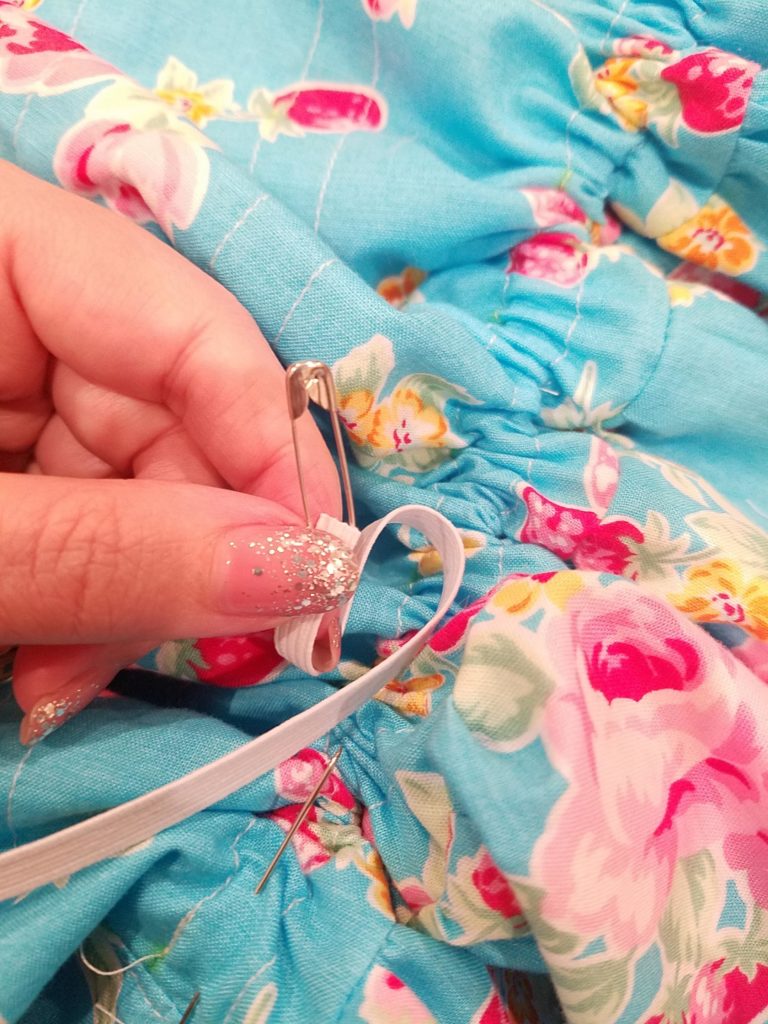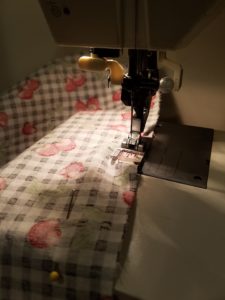Lolita Myths: Alterations Always Lower Resale Value in Lolita
Before we get into alterations, lets first talk about what resale value is. In short, resale value is the monetary value of an item when sold second hand. For lolita items, two things impact resale value: Supply & Demand and Condition/Quality.
Supply & Demand

The most classic example of supply and demand is what most lolita think of when they think of the term. That is, we have a very specific item. Let’s say Angelic Pretty’s Puppet Circus JSK in red.
Let’s say there are 100 copies of this dress and 1000 people who want it (totally made up numbers). If one of these went up for sale, there would be 899 people competing for the same dress (assuming the previous owner no longer wants it, and the other 99 owners are content with 1 copy), and if it was put up for auction it would sell to the person in that group of 899 people who offered the most money. That would be it’s “resale value” and in this case, it’s well above retail.
Let’s say Angelic Pretty re-released it (hypothetically, of course, they say they won’t re-release their printed velvet). And in the re-release they added another 1,000 pieces. That would be enough for all the 1,000 people who wanted it to get one, and there would be 100 left over. The resale value would then be less than retail value because there were more copies than people interested (and more copies than people willing to pay retail price).
But, there is another aspect to supply and demand. And that is that sometimes, a piece doesn’t have people who are dedicated and in love with it. It still has a resale value though. There is a general resale value. A Angelic Pretty dress has a base value no matter how unpopular it is, there are still people who would buy it if it was cheap enough.
In fact, all lolita pieces that don’t have a major issue have a base value. If I list a brand dress in NWT condition on lace market for $20 it’s going to sell. General resale value, where it’s not valued as a specific item, depends on a few factors. How pretty the item is, what size range it fits, if it’s a flattering cut, etc.
Condition / Quality

The other thing that impacts resale value of an item in lolita is condition and quality. Is it stained or damaged in any way? Is the fabric worn or pilled? Are their factory defects? Is the overall material and workmanship good?
A dress that has a high demand under specific item supply and demand, might still be worth more than retail value even with small flaws.
A dress that has low specific item supply and demand, however, is very dependent on quality and condition.
For example, most Putumayo items don’t resell for a lot even in perfect condition, so for Putumayo, the condition of the item can quickly erode what little value it had. In cases like this, attempting to remove stains or repair other issues, even if the repair changes the design a little, will almost always add value if the end result is well executed.
Types of Alterations

Alterations come in many forms. In some cases, an alteration corrects a flaw, either a factory flaw or a flaw caused by use, like mending a stain or tear. If the quality of the alteration is equal or greater than the quality of the original item (aka if the seamstress who does the work is equally or more skilled than the one who made the item) this almost always increases the resale value of the specific copy of the item, because it removes the flaw which was decreasing the value. However, if the quality of the work is poor, it can lower the value because the work itself is considered a flaw.
In other cases, alterations are cosmetic. The owner dislikes something and changes it. If the workmanship is good, and it makes the item appealing to more people, this can raise the resale value, or keep steady. For example, removing an poor quality ribbon bow from a Bodyline dress usually won’t negatively impact the value. Skillful replacement of poor quality lace generally raises the value of an item.
Likewise, changing a relatively unknown skirt into a skirt with a fancy back bustle, or swapping the bodice of a relatively unknown dress for a different fabric for example, if done with at least the same level of skill as the original work, would increase or decrease the base value based on how appealing the end result was to a non-specific buyer.
However, taking a lolita dress and cutting off the bottom border print and hemming it into a micro mini skirt would almost always tank the resale value to another lolita because the alteration makes it no longer lolita.
Finally, there are alterations that change the measurements of an item to better fit a specific person. These alterations, again, when done with skill in a way that looks good, can either impact the value negatively or positively depending on if the alteration makes the pool of people who would fit into the dress and want it larger or smaller. Generally speaking, altering something smaller makes that pool of people smaller, but alterations which go a little bit larger, tends to increase the pool of people up until a point.
But, a word of caution: if the alteration to change the measurements is sloppy (for example, adding a side panel in a fabric that doesn’t match with sloppy sewing) it is going to harm the resale value of a piece because it lowers the overall quality of the piece, even though it would open it up to more potential buyers. For this reason, I generally recommend having all alterations done by a professional unless you are skilled enough at sewing to draft your own sewing patterns.
All that said, any alteration which is unappealing, or poorly done will generally lower the value of a piece.
Bonus Myth: Alterations Are Easy / Fast

Majorly altering a lolita garment can be more time consuming and is generally more fussy than making a piece from scratch. Because of this, many lolita seamstresses don’t do alterations. It’s just not cost effective, and a certain lolita seamstress who I know that has done a couple for me in the past won’t even help me estimate the time it would take to do certain alterations because just thinking about it made her feel stressed/annoyed.
This means that having a skilled lolita seamstress modify a dress for you may cost a significant amount compared to the original cost of the dress. So if it’s not a dress you love, alteration may not always be the best choice, it might make more sense to sell the piece and buy something else closer to what you actually want.
Have you ever had a dress altered, or bought an altered piece? Let me know in the comments!

I mod and recon lolita dress into plus size. I currently only work w my close friends due to heavy time constraints.
1) removing the skirt from the bodice, harvesting lace, and deconstructing the bodice take as long as modding and finishing. It has to be done delicately and you must spend considerable effort cleaning threads.
2) modding a bodice often involves drafting and fitting a mockup on the client.
3) You must use absolute caution and make very firm decisions *before* you cut and proceed. If you make a drastic error, you owe someone to replace the dress, if it can even be found. You must be incredibly careful.
4) depending on the material, I will say no. If I don’t have six months or a very flexible schedule, I will say no. If the cut wont work, I will say no. I have to be really careful to obly accept mod jobs that I have 100% measured and know I have doner fabric to cover.
5) Modding 2 dress into plus size usually takes me around 10-16 hours, more if I have to mockup a bodice. My mods often run around $200-$300 worth of labor.
A double garment plus size dress skillfully modded by me can be worth anywhere from $600-$1000 when finished, including the cost of the originals.
No, I am not open for projects, I’m sorry.
Another very well written post. People do have a tendency to lump all kinds of alterations into the same sack, when they aren’t all equal. And seeing the number of people who were finally able to buy their dream dresses because they saw a listing for an altered one that would fit, instead of having to do the alteration themselves, really goes to show that a well done alteration at the very least will not devalue the dress in relation to its retail price.
I’ve had two dresses significantly altered, both by people who knew what they were doing. I had my very first lolita JSK from Bodyline altered from being a halterneck to a regular strap one (and even got a bow hair tie made with the leftover scraps), And later a dress from a Chinese brand, which wasn’t fitting me as nicely as I would’ve liked, I sent to a lolita who is also a pro at alterations and a trained pattern cutter, who turned it from slightly too high waisted for me to perfect by extending the bodice. Both of those I now wear a lot more than I would have previously. Oh, and I had an ouji jacket from AatP altered to fit me, I almost forgot about that one 😛
So now that I read your post and wrote that comment, I’m thinking that maybe I should just bite the bullet and alter another dress that I’m holding onto. Right now it isn’t the most flattering or comfortable, though I can fit into it, but I’ve always hesitated before committing to any permanent alteration, but I think that since I do want to hold onto it, it would be better to have it fit me better than worry about its resale value.
I got a local tailor shop with experience in formalwear to alter my Gathered Chiffon by using the waist ties fabric to make the bodice larger. It’s been done really well and you can’t tell at all. I have every confidence that if I were to ever sell it I would get back at least what I paid for it.